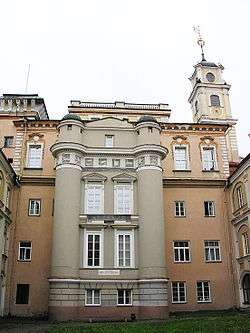Marcin Knackfus

Marcin Knackfus (Lithuanian: Martynas Knakfusas, c. 1742 – c. 1821) was a Polish–Lithuanian Neoclassical architect of German descent. Born near Warsaw, he worked in the Grand Duchy of Lithuania and particularly in its capital Vilnius. He was a tutor of Laurynas Gucevičius.[1]
Knackfus was influenced by other Polish–German architects of late Baroque (Ephraim Schröger and Szymon Bogumił Zug) and early Neoclassicism (Domenico Merlini and Johann Christian Kammsetzer).[2] He moved to Vilnius around 1768. Knackfus served as captain of the Army of Grand Duchy of Lithuania and lectured at military engineering school.[3] Between 1773 and 1777 he taught courses in theory and practical application of architecture at Vilnius University.[4] He participated in the 1794 Kościuszko Uprising. Fearing persecutions of the Tsarist authorities, he retreated to Suvalkija and largely retired.[5]
His works include Verkiai Palace (1769–1781),[6] Palace of de Reuss in front of the Daukantas Square (1775),[7] expansion of Astronomical Observatory of Vilnius University (1782–1788),[8] late Baroque churches of Troškūnai (1774–1787) and Kurtuvėnai (1783–1792),[9] Vilnius Botanical Garden (1784),[3] altar for All Saints Church, Vilnius (1787),[9] St. Bartholomew Church in Užupis (1788),[10] supervision of the construction of the Green Bridge (1789),[11] church in Trakai (1789–1790),[9] Tyzenhaus Palace (around 1790), archives of the Lithuanian Tribunal (1790),[12] residential palace (presently used by Vilnius Conservatory of Juozas Tallat-Kelpša; 1790),[13] manor and park in Paežeriai, Vilkaviškis district (1794),[5] parish school in Troškūnai (1796),[5] Basanavičius street in Vilnius (1798).[14]
Knackfus worked with numerous nobles, including Bishops Ignacy Jakub Massalski and Ignacy Krasicki, Field Hetman Ludwik Tyszkiewicz, voivode Karol Stanisław Radziwiłł, Adam Kazimierz Czartoryski, Grand Marshal Stanisław Lubomirski.[15]
References
| Wikimedia Commons has media related to Marcin Knackfus. |
- Notes
- ↑ Čerbulėnas (1994), p. 295
- ↑ Čerbulėnas (1994), pp. 275–276
- 1 2 Čerbulėnas (1986), p. 346
- ↑ Čerbulėnas (1994), p. 273
- 1 2 3 Čerbulėnas (1994), p. 279
- ↑ Drėma (1991), p. 383
- ↑ Drėma (1991), p. 324
- ↑ Klimka (2003), p. 651
- 1 2 3 Čerbulėnas (1994), p. 276
- ↑ Drėma (1991), p. 358
- ↑ Drėma (1991), p. 376
- ↑ Drėma (1991), p. 120
- ↑ Drėma (1991), p. 171
- ↑ Čerbulėnas (1994), p. 208
- ↑ Čerbulėnas (1994), p. 487
- Bibliography
- Čerbulėnas, Klemensas (1986). "Knakfusas, Martynas". In Jonas Zinkus; et al. Tarybų Lietuvos enciklopedija. 2. Vilnius: Vyriausioji enciklopedijų redakcija. LCC 86232954. (Lithuanian)
- Čerbulėnas, Klemensas (1994). Lietuvos architektūros istorija: Nuo XVII a. pradžios iki XIX a. vidurio (in Lithuanian). II. Vilnius: Mokslo ir enciklopedijų leidykla. ISBN 5-420-00583-2.
- Drėma, Vladas (1991). Dingęs Vilnius (in Lithuanian). Vilnius: Vaga. ISBN 5-415-00366-5.
- Klimka, Libertas (2003). "Overview of the History of Vilnius University Observatory". Baltic Astronomy. 12 (4). Bibcode:2003BaltA..12..649K. ISSN 1392-0049.